This article was co-authored by Lyssandra Guerra. Lyssandra Guerra is a Certified Nutrition & Wellness Consultant and the Founder of Native Palms Nutrition based in Oakland, California. She has over five years of nutrition coaching experience and specializes in providing support to overcome digestive issues, food sensitivities, sugar cravings, and other related dilemmas. She received her holistic nutrition certification from the Bauman College: Holistic Nutrition and Culinary Arts in 2014.
There are 20 references cited in this article, which can be found at the bottom of the page.
wikiHow marks an article as reader-approved once it receives enough positive feedback. In this case, 80% of readers who voted found the article helpful, earning it our reader-approved status.
This article has been viewed 511,378 times.
Eating a balanced diet gives your body all the nutrients it needs from a wide variety of different foods. In this day and age, you might find it difficult to maintain a healthy diet. Fortunately, we've got lots of tips and tricks to help you stick to a healthy routine so you can be at your best.
Steps
Planning for a Balanced Diet
-
1Write a meal plan. Writing out a weekly meal plan can help you make sure you're consuming a well-balanced diet. Plan meals and snacks to have throughout the day so that you'll be eating each food group every day.[1]
- Take an hour or two of your free time and write up your ideas for all meals and snacks.
- Try tallying up all the food groups for each daily meal plan. Did you include dairy each day? How about enough fruits or vegetables?
- If you're busy or on the go, plan for meals that are quick, require little cooking, or recipes that you can freeze for easy-to-prepare meals.
- Search online for sample meal plans and inspiration.
-
2Go grocery shopping. Stocking your kitchen with healthy foods from each food group will help make preparing balanced meals and maintaining a balanced diet easy. After you write up your meal plan, make time to go grocery shopping to stock up on a variety of your favorite healthy items.[2]
- A well-stocked pantry can be a great tool for maintaining a balanced diet. Stock up on shelf-stable foods for quick and easy balanced meals: canned beans, no-salt-added canned vegetables, canned tuna or chicken, 100% whole grains (like quinoa, 100% whole wheat pasta or brown rice), and nut butter.
- Stock up on frozen items like vegetables (without sauces or seasonings), fruit, pre-cooked grains (like brown rice or quinoa), low-calorie dinners (for busy nights), and proteins (fish or chicken).
- Keep a supply of fresh fruits, vegetables, dairy (like low-fat milk, yogurt, and cheese), and lean proteins (chicken, fish, pork, or lean beef).
Advertisement -
3Start a food journal. Keeping a food journal can help you maintain a balanced diet in two ways. First, it can help you review your current diet and allow you to see what areas your diet is lacking. And second, it's a great method to keep you on track long-term.[3]
- Purchase a journal or download a journaling app on your smartphone. Track as many days as you can. Pay attention to the 5 food groups—are you consuming all of them each day?
- We are often unaware if we are eating too much or too little of something. A food journal can bring this information to light.
- When first starting, note where you think you can make improvements or better choices. For example, maybe you're not a big vegetable fan and you typically skimp on this group, or you eat a lot of the same foods each week without much variety.
-
4Talk to your doctor or registered dietitian. A registered dietitian is a nutrition expert that can give you a ton of guidance on balanced diets and healthy eating. They will be able to educate you on the benefits of a balanced diet, show you where your diet is lacking, and give you meal plans and tips to help you reach a more balanced diet.[4]
- Speak with your primary care doctor. Your doctor is most likely aware of your health and medical conditions and may be able to give you general recommendations for certain foods or a diet pattern that can help you achieve not only a balanced diet, but one that may improve your overall health. They may also be able to refer you to a local dietitian for additional help.
- Visit https://www.eatright.org/find-a-nutrition-expert to search for a dietitian in your area.
Preparing Balanced Meals
-
1Eat foods from all 5 food groups. One of the cornerstones to eating a balanced diet is consuming foods from each of the 5 food groups: protein, vegetables, fruits, dairy, and grains.[5] Each food group offers different vital nutrients that your body needs. Aim to consume foods from each group everyday.[6]
- Protein is essential to all cells and processes in your body—anything from building and repairing tissues to making enzymes, hormones, and other chemicals. Ideally, choose lean protein foods like poultry, eggs, lean beef, seafood, nuts, and beans.[7]
- Dairy foods also contain protein but are known for being high in calcium, potassium, and vitamin D. Choose low-fat dairy products like yogurt, milk, cheese, or kefir.[8]
- Fruits and vegetables are 2 food groups that offer a host of nutrients including vitamins, minerals, fiber, and antioxidants.[9] They are also low in calories which makes them an essential component of a balanced diet. Choose a variety of fruits and vegetables each day.[10]
- The grain group can be split into two separate groups: whole grains (like brown rice, quinoa, or oatmeal) and refined/processed grains (white bread, white rice, or plain pasta). Aim to make at least half of all your grain choices 100% whole grain. These types of grains are high in fiber, protein, and other essential nutrients.[11]
-
2Add some healthy fats. Some types of fat are known as "heart-healthy" including omega-3 fats and monounsaturated fats. These have been shown to have some health benefits including maintaining or improving blood lipid levels or supporting the brain development of infants.[12]
-
3Eat at least 3 meals daily. A balanced diet goes beyond just the foods in your meals. You also need to balance the amount of food you consume throughout the day. It's beneficial to consume regular, frequent meals throughout the day.[16]
- Eating 3 or more meals a day or including snacks makes it easier for you to consume all the recommended amounts of essential nutrients you need each day. Skipping meals puts you at risk of not being able to consume what you need.
- Regular, frequent meals and snacks provide a steady flow of energy to your brain. The fairly even blood sugar level helps your brain function well.
- An example of one day of balanced eating may look like: scrambled eggs with vegetables and cheese for breakfast; whole wheat wrap with lean turkey and cheese and 1 cup baby carrots for lunch; a small apple and a cheese stick for an afternoon snack; and large spinach salad with raw vegetables and 4 oz. of grilled salmon for dinner.
-
4Drink plenty of clear fluids. While you may have heard that you should drink 8 glasses of water daily, there actually isn’t a cut-and-dry recommendation for water intake. Instead, your goal should be to stay well hydrated.[17] Drink water and other clear, sugar-free liquids and eat foods with high water content, including fruit like watermelon and broth-based soups.[18]
- Choose liquid like water, iced tea, decaf coffee, or no-calorie flavored waters.
- Purchase a water bottle to help you monitor the volume of liquids you consume throughout the day.
-
5Measure your portion sizes. Consuming adequate portions of all foods is important to a balanced diet. It will make sure that you're eating enough of certain food groups and also not eating too much of others.[19]
- In general, portion sizes of fruits and vegetables can and should be larger compared to servings of items like grains. These low-calorie, nutrient-packed foods should make up about 50% of your meals and snacks.
- Foods from the grain group like pasta, rice or bread should be monitored. It can be easy to overdo it from this group, which can throw off the balance of your diet. 1/2 cup of grains like rice or pasta is a serving and 1 oz of items like bread is also 1 serving.
- Dairy and protein-based foods offer a lot of nutrition and should be consumed at most meals and snacks. Consuming 3-4 oz protein, 1 cup or 1 oz of dairy foods are appropriate portion sizes.
Indulging in Moderation
-
1Limit your sugar and saturated fat intake. Foods that are high in sugar and high in fat are generally also high in calories. In addition, they're generally not very high in nutrients like vitamins and minerals. Eating too many of these types of foods can make it difficult to maintain a balanced diet.[20]
- Maintaining a balanced diet does not mean avoiding favorite items like sweets or high-fat indulgent foods like macaroni and cheese. Choose these foods in moderation and enjoy them occasionally and in portion-controlled servings.
- Decide what moderation is for you. It may mean splitting dessert every Friday night or going out to your favorite burger place twice a month.
-
2Cut back on alcohol and other liquid calories. Drinking liquid calories is a common way to throw off a balanced diet quickly. They're high in calories and sugar and can rapidly increase your total intake of sugar.[21] Monitor how often and how much you're consuming items like beer, wine, mixed drinks, sodas, sweetened tea, or juice.
- Although 100% fruit juice does have some nutritional benefit, juice still contains a relatively high amount of sugar and should be consumed in moderation.[22]
- Skip sodas and sugary drinks. If you still need caffeine, consider coffee or tea with skim milk and limited sweetener.
- Limit alcoholic beverages as well. Aim for 1 drink or less daily for women and 2 drinks or less daily for men.[23]
- An occasional glass of wine or sweetened tea is okay. Again, it's important to enjoy these items in moderation.
-
3Engage in physical activity. Exercise is an important part of a healthy and balanced lifestyle. Although it doesn't necessarily affect your diet, regular physical activity can help maintain your weight and health when you occasionally indulge in favorite foods.[24]
Balanced Meal Ideas
References
- ↑ Lyssandra Guerra. Certified Nutrition & Wellness Consultant. Expert Interview. 25 March 2020.
- ↑ Lyssandra Guerra. Certified Nutrition & Wellness Consultant. Expert Interview. 25 March 2020.
- ↑ https://www.cdc.gov/healthyweight/losing_weight/eating_habits.html
- ↑ http://eatright.org
- ↑ Lyssandra Guerra. Certified Nutrition & Wellness Consultant. Expert Interview. 25 March 2020.
- ↑ https://www.usda.gov/media/blog/2017/09/26/back-basics-all-about-myplate-food-groups
- ↑ https://www.myplate.gov/eat-healthy/protein-foods
- ↑ http://www.choosemyplate.gov/dairy
- ↑ https://www.myplate.gov/eat-healthy/fruits
- ↑ https://www.myplate.gov/eat-healthy/vegetables
- ↑ https://www.choosemyplate.gov/eathealthy/grains
- ↑ Lyssandra Guerra. Certified Nutrition & Wellness Consultant. Expert Interview. 25 March 2020.
- ↑ https://www.cdc.gov/diabetes/prevention/pdf/postcurriculum_session2.pdf
- ↑ https://www.cdc.gov/diabetes/prevention/pdf/postcurriculum_session2.pdf
- ↑ https://www.heart.org/en/healthy-living/healthy-eating/eat-smart/fats/monounsaturated-fats
- ↑ Lyssandra Guerra. Certified Nutrition & Wellness Consultant. Expert Interview. 25 March 2020.
- ↑ https://www.ncbi.nlm.nih.gov/pmc/articles/PMC2908954/
- ↑ https://health.gov/sites/default/files/2019-09/2015-2020_Dietary_Guidelines.pdf
- ↑ https://www.nia.nih.gov/health/know-your-food-groups
- ↑ https://medlineplus.gov/ency/patientinstructions/000838.htm
- ↑ https://www.ncbi.nlm.nih.gov/pmc/articles/PMC2676995/
- ↑ http://www.choosemyplate.gov/fruit
- ↑ http://www.cdc.gov/alcohol/faqs.htm
- ↑ http://www.health.gov/paguidelines/
- ↑ https://www.heart.org/en/healthy-living/fitness/fitness-basics/aha-recs-for-physical-activity-in-adults
- ↑ https://www.heart.org/en/healthy-living/fitness/fitness-basics/aha-recs-for-physical-activity-in-adults
About This Article
Start your new balanced diet by creating a meal plan that includes space for three meals and two snacks each day to help you get all of the nutrients you need. To get the right portions of each food group, remember that 3 to 4 ounces of protein, 1 cup of dairy, and a half a cup of grains are all equal to one serving from that food group. Then, round out your meals and snacks with fruits and vegetables, which should make up about 50% of your overall diet. For more tips from our Nutritionist reviewer, including how to indulge in moderation, keep reading!





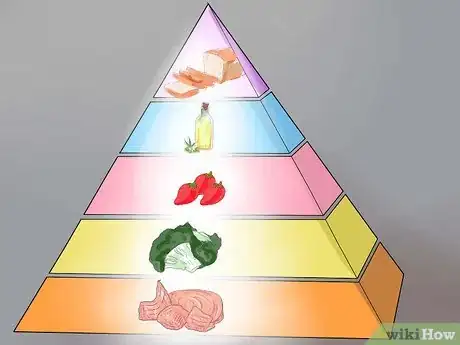
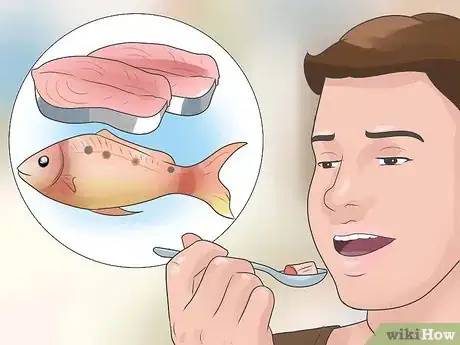

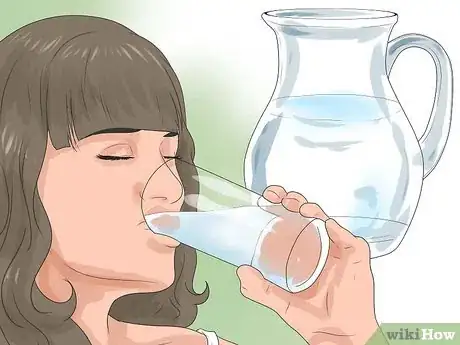
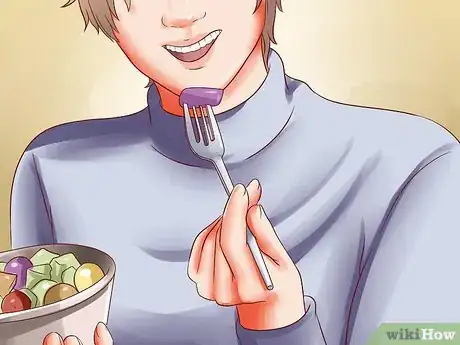














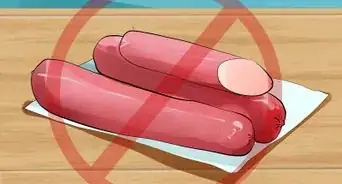




















































Medical Disclaimer
The content of this article is not intended to be a substitute for professional medical advice, examination, diagnosis, or treatment. You should always contact your doctor or other qualified healthcare professional before starting, changing, or stopping any kind of health treatment.
Read More...